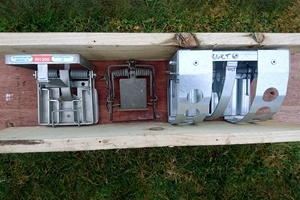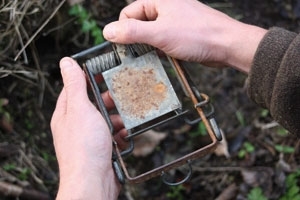By Hugo Straker and Mike Swan, GWCT Advisors
 DOC trap (left) and Tully (right) are two options for stoats
DOC trap (left) and Tully (right) are two options for stoats
from 1 April 2020.Stoats are a widespread and common predator of gamebirds and many other ground nesting species, and are widely trapped by gamekeepers for game management and wildlife conservation purposes, using the system known as tunnel trapping. Even where they are not a specific target, stoats may well enter traps set for other species such as rats and grey squirrels.
1 April 2020 heralded ‘all change’ to the practice of tunnel trapping throughout the UK and the change will likely have most impact where wild game populations are being managed, with its inevitable emphasis on stoat and weasel control. Landowners, managers and keepers must all embrace this change – like it or not.
The 2018/19 Spring Traps Approval Orders for England, Scotland, Wales and Northern Ireland formalised the end of the historically popular Fenn-type spring traps (amongst others) for stoat control. As of 1 April 2020, these must be replaced with a new generation of traps which have been approved by Defra for stoat capture. These currently include the DOC trap series (150, 200 and 250) Tully trap and Goodnature A24 stoat and rat trap. All have been designed to minimise suffering by killing target species rapidly within a specified time frame.
Regardless of trap type, each must be deployed in a way that minimises the risk to non-target species. Approved stoat traps must still be used in tunnels “suitable for the purpose”, and in the case of the DOC series, there are particular specifications that are part of the approval (see below). A range of materials can be used for this, including weldmesh, which is often favoured for ‘rails’ set over ditches and watercourses, to reduce flow resistance if traps and tunnels are submerged during a flood. In this case 25mm square weldmesh should ideally be used for tunnel construction to help minimise the risk of non-targets being caught by pushing a foot through from above. The tunnel, whether run-through or blind-ended and baited, must also have excluders at the entrance(s) to deter non-targets.
In the case of DOC traps, tunnel construction must adhere to manufacturer’s guidelines; choice of materials can be flexible, but positioning of traps in relation to baffles must be according to DOC trap instructions as presented to the UK by the New Zealand Department of Conservation in 2019.
DOC traps must be used with a baffle alongside the trap to ensure a humane strike. In addition – as with all spring traps – use of the trap must (by law) reasonably balance the successful capture of target species with minimal risk to non-target species. Non-target animals larger than the target species can be prevented from reaching the trap by adding an ‘excluder’ to the tunnel entrance(s). For decades it has been common practice to narrow the entrance using two sticks or whatever came to hand. Nowadays there is at least some knowledge of the size of gap that different species can get through (depending how much they want to, of course) and something less arbitrary is expected. However, to allow for the many different circumstances and personal preferences, there is no definitive requirement. Every trapper must consider the non-target species exposed to traps in their area and be prepared to defend their tunnel design.
For those wanting a recommendation, we suggest that where stoats and weasels are the main target, tunnel excluders should have apertures no larger than the 51mm used in the DOC run-through trap baffle. This keeps things simple, is defensible, and is amply big enough for stoats and weasels to enter. Excluders can be set back inside the tunnel entrance, but we suggest they should be at least 15cm away from the trap, to avoid non-target species reaching the trap by inserting beaks, heads or paws.
For trappers targeting grey squirrels (and rats) with DOC traps, a larger excluder aperture is better. To minimise exposure of non-targets, we recommend that trapping (in woodland) is concentrated into short periods of a week or ten days, repeated 2-3 times a year, each time preceded by pre-baiting for at least a week with whole maize. For grey squirrels, DOC traps must be used in single-entry tunnels, which should also be baited with maize (DOC traps in run-through configurations have not been approved for grey squirrels).
Designs for Tully tunnels are up to individual operator discretion but must minimise the risk of non-target capture; again, we recommend an excluder no larger than 51mm where weasels and stoats are the principle target species.
Positioning of traps in tunnels is also important and will determine the length of each tunnel. Traps need to be kept far enough back from the entrance to avoid the risk of non-target capture by paw, claw or beak; 150mm back from the entrance is recommended. With the trap placed in the middle of the tunnel, the total length should then be no less than 460mm (18”).
Where red squirrels are present, we strongly discourage the use of rail traps. Trappers should always carefully assess the risk of non-target capture as there are some areas where the risk is higher and red squirrels seem naturally drawn to rails; particularly those set across waterways. Under the Wildlife and Countryside Act 1981, as amended, it is illegal to set any trap likely to kill or cause bodily injury to any wild animal in schedules 5 or 6, which includes red squirrels. Continued use of rail traps in or close to red squirrel woods could jeopardise future use of rail traps as part of a legitimate predator control programme. If in doubt, do not set a kill trap.
Using Fenn and bodygrip traps after 1 April 2020
 The popular Fenn-type trap, and the BMI bodygrip remain a legal for weasels, after 1 April, but trappers must reduce excluder apertures on any boxes/rails that remain with these traps to minimise the risk of stoat capture. Because of the overlap in body size between weasels and stoats, it is very unlikely that a physical excluder can be devised that will allow weasels to pass through while excluding stoats. We therefore urge trappers to fully embrace change and demonstrate full compliance with the law by switching to new generation stoat traps for both species.
The popular Fenn-type trap, and the BMI bodygrip remain a legal for weasels, after 1 April, but trappers must reduce excluder apertures on any boxes/rails that remain with these traps to minimise the risk of stoat capture. Because of the overlap in body size between weasels and stoats, it is very unlikely that a physical excluder can be devised that will allow weasels to pass through while excluding stoats. We therefore urge trappers to fully embrace change and demonstrate full compliance with the law by switching to new generation stoat traps for both species.
The old traps will also remain legal for rats and grey squirrels, but there are surely very few situations where a keeper can target these species in full confidence that there is no risk of catching a stoat. Trapping in the roof space of the keeper’s house might be an exception, but stoats will enter barns and farm buildings. They are also good climbers, so even grey squirrel traps in purpose-built boxes sited in trees remain a grey area, and anyone who takes a chance is surely at risk of becoming a test case.
New traps in the pipeline
The new PX3 kill trap, designed by Perdix Wildlife Supplies, has now passed Defra testing according to international humane trapping standards. This new trap has been passed for the taking and killing of stoat, weasel, rat and grey squirrel in both single entry and run through configurations and has now entered the legislative process to be formally approved onto the Spring Traps Approval (Amendment) Orders of the UK.
The change to trapping will likely mean fewer traps being deployed due to the expense of new approved stoat traps. Whilst the extra cost may challenge some shoot budgets, we encourage trappers to adapt to new designs and work away with these new humane traps learning how to incorporate them into their predation control strategies. We are encouraged that some keepers who have been using good numbers of new traps for some while are reporting considerable success at weasels, stoats and other target species.
Our FAQ on the implementation and consequences of the Agreement on International Humane Trapping Standards (AIHTS) can be found here.